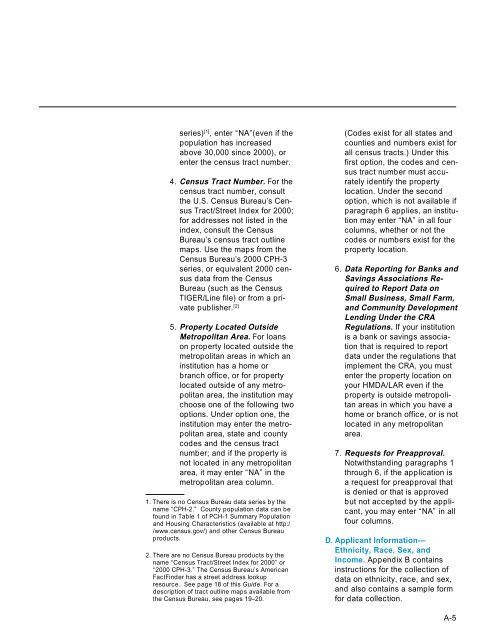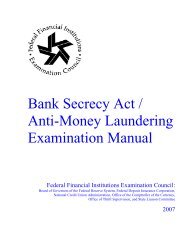A Guide to HMDA Reporting - ffiec
A Guide to HMDA Reporting - ffiec
A Guide to HMDA Reporting - ffiec
Create successful ePaper yourself
Turn your PDF publications into a flip-book with our unique Google optimized e-Paper software.
series) [1] , enter “NA”(even if the<br />
population has increased<br />
above 30,000 since 2000), or<br />
enter the census tract number.<br />
4. Census Tract Number. For the<br />
census tract number, consult<br />
the U.S. Census Bureau’s Census<br />
Tract/Street Index for 2000;<br />
for addresses not listed in the<br />
index, consult the Census<br />
Bureau’s census tract outline<br />
maps. Use the maps from the<br />
Census Bureau’s 2000 CPH-3<br />
series, or equivalent 2000 census<br />
data from the Census<br />
Bureau (such as the Census<br />
TIGER/Line file) or from a private<br />
publisher. [2]<br />
5. Property Located Outside<br />
Metropolitan Area. For loans<br />
on property located outside the<br />
metropolitan areas in which an<br />
institution has a home or<br />
branch office, or for property<br />
located outside of any metropolitan<br />
area, the institution may<br />
choose one of the following two<br />
options. Under option one, the<br />
institution may enter the metropolitan<br />
area, state and county<br />
codes and the census tract<br />
number; and if the property is<br />
not located in any metropolitan<br />
area, it may enter “NA” in the<br />
metropolitan area column.<br />
1. There is no Census Bureau data series by the<br />
name “CPH-2.” County population data can be<br />
found in Table 1 of PCH-1 Summary Population<br />
and Housing Characteristics (available at http:/<br />
/www.census.gov/) and other Census Bureau<br />
products.<br />
2. There are no Census Bureau products by the<br />
name “Census Tract/Street Index for 2000” or<br />
“2000 CPH-3.” The Census Bureau’s American<br />
FactFinder has a street address lookup<br />
resource. See page 18 of this <strong>Guide</strong>. For a<br />
description of tract outline maps available from<br />
the Census Bureau, see pages 19–20.<br />
(Codes exist for all states and<br />
counties and numbers exist for<br />
all census tracts.) Under this<br />
first option, the codes and census<br />
tract number must accurately<br />
identify the property<br />
location. Under the second<br />
option, which is not available if<br />
paragraph 6 applies, an institution<br />
may enter “NA” in all four<br />
columns, whether or not the<br />
codes or numbers exist for the<br />
property location.<br />
6. Data <strong>Reporting</strong> for Banks and<br />
Savings Associations Required<br />
<strong>to</strong> Report Data on<br />
Small Business, Small Farm,<br />
and Community Development<br />
Lending Under the CRA<br />
Regulations. If your institution<br />
is a bank or savings association<br />
that is required <strong>to</strong> report<br />
data under the regulations that<br />
implement the CRA, you must<br />
enter the property location on<br />
your <strong>HMDA</strong>/LAR even if the<br />
property is outside metropolitan<br />
areas in which you have a<br />
home or branch office, or is not<br />
located in any metropolitan<br />
area.<br />
7. Requests for Preapproval.<br />
Notwithstanding paragraphs 1<br />
through 6, if the application is<br />
a request for preapproval that<br />
is denied or that is approved<br />
but not accepted by the applicant,<br />
you may enter “NA” in all<br />
four columns.<br />
D. Applicant Information—<br />
Ethnicity, Race, Sex, and<br />
Income. Appendix B contains<br />
instructions for the collection of<br />
data on ethnicity, race, and sex,<br />
and also contains a sample form<br />
for data collection.<br />
A-5
















